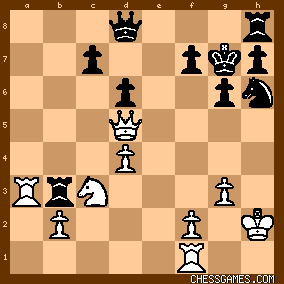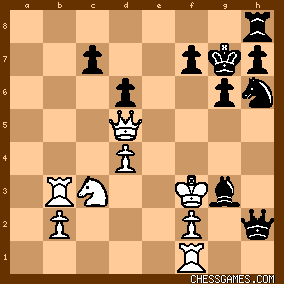| Feb-15-03 | | siimens: 22.Ra3?
one of the many self-lost games on that Keres memorial by Oll
Oll-M.Gurevich of course is a classic |
|
| Oct-29-20 | | Amarande: Why not take the Rook?
True, 24 Rxb3, leaving the Queen exposed on d5, appears to lose fatal material - after 24 ... Qh4+ 25 Kg1 Ng4 White must move the Rf1 to avoid mate, and after e.g. 26 Rd1 (26 Re1 Qxf2+ 27 Kh1 Qxe1#, while other rook moves lose the Queen in the same fashion as Rd1) Qxf2+ (it is essential to remove this pawn) 27 Kh1 Qh4+ 28 Kg1 Qh2+ 29 Kf1 Ne3+ and picks up the Queen. I'm not seeing how Black wins after 24 Qxb3 Qh4+ 25 Kg1 Ng4 26 Rd1, however? |
|
Oct-29-20
 | | al wazir: My idea was the immediate 23...Qh4+ 24. Kg1 Ng4, followed by 25. Re1 Qh2+ 26. Kf1 Qh1+, and if 27. Ke2, and then a ♔ hunt: 27...Rbe8+ 28. Kf3 Qxe1 29. Qxf7+ Kh6 30. Qf4+ g5 31. Qxg4 Rhf8+ 32. Kg3 Qxf2+ 33. Kh2 Rf4, etc. But after 25. Qxf7+ Kh6 26. Qf4+ g5 27. Qg3, black is a piece down with no attack. |
|
| Oct-29-20 | | goldfarbdj: <Amarande>: <I'm not seeing how Black wins after 24 Qxb3 Qh4+ 25 Kg1 Ng4 26 Rd1, however?>
I think 26 ... Qxf2+ 27 Kh1 Ne3 does the trick. There is no viable defense against mate on g2, since if 28 Rg1 now Qh4 is mate. |
|
| Oct-29-20 | | Predrag3141: The puzzle of the day starting before Black's 22nd move has to involve ... Bxh2+ and ... Rxb3, but it took a while to work out when to play each. <Rxb3 first> 22 ... Rxb3 23 Rxb3 Bxh2+ 24 Kh1 Qh4 25 g3 looks advantageous to Black but unclear because White has banked an exchange and Black gets two pawns plus exposing White's king. <Rxb3 second> the game continuation; Black wins the b-pawn as well as the h-pawn. <Rxb3 third> 22 ... Bxh2+ 23 Kxh2 Qh4+ 24 Kg1 Rxb3 25 g3 loses for Black. My conclusion: <Rxb3 second> gives Black the clearest advantage. Stockfish disagrees though. The complications are very favorable to Black in the <Rxb3 first> line above. The game play is significantly weaker than that. |
|
| Oct-29-20 | | BxChess: <Amarande:> 24. Qxb3 Qh4+ 25. Kg1 Ng4 26. Rd1 Qxf2+ 27. Kh1 Qh4+ 28. Kg1 Qh2+ 29. Kf1 Re8
seems to give mate or loss of knight and queen. |
|
| Oct-29-20 | | Walter Glattke: White treatens Qxf7, if Ng4, so 22.-Bxh2+ A) 23.Kh2 Qh4+ 24.Kg1 Rxb3 25.Rxb3 Ng4 26.Re1 Qh2+ 27.Kf1 Qh1+ 28.Ke2 Re8+ 29.Ne4 Qxg2 (or -f5) 30.Rg3 Rxe4+! B) 22.-Bxh2+ 23.Kh1 Qh4 24.Re1 (or f3? Ne4? Bg3+ mate next) Bg3+ 25.Kf1 Qh1+ 26.Ke2 Rhe8+ 27.Ne4 Qxg2 28.Kd3 f5 possibly not perfect, A2) 25.Qxb3 Ng4 26.Re1 Qxf2+ 27.Kh1 Qxe1# A3) 22.-Rxh2+ 23.Kxh2 Rxb3!? 24.g3 instead of 24.Kg1 |
|
| Oct-29-20 | | Brenin: I went for 22 ... Rxb3 first, which looks more decisive than the move 22 ... Bxh2+ played, winning just 2P. White's 27 Ng5 was unwise, leaving his Q tied to N protection duties; Re3 was better. |
|
| Oct-29-20 | | Lambda: After 24 Qxb3 Qh4+ 25 Kg1 Ng4 26 Rd1 I went for eliminating the f-pawn then playing Re8 to cut off the escape route for the white king. |
|
| Oct-29-20 | | Walter Glattke: 22.-Rxb3 is good, but 22.-Bxh2+ 23.Kxh2 23.-Rxb3 allows 24.g3, that is good for white, I set this as A3) above. |
|
Oct-29-20
 | | Honza Cervenka: 22...Rxb3 23.Rxb3 Bxh2+ 24.Kh1 (24.Kxh2 Qh4+ 25.Kg1 Ng4 26.Rd1 Qxf2+ 27.Kh1 Qh4+ 28.Kg1 Re8 29.Ne4 Qh2+ 30.Kf1 Qh1+ 31.Ke2 Qxg2+ 32.Kd3 Rxe4 33.Qxe4 Nf2+ -+) 24...Qh4 25.g3 Bxg3+ 26.Kg2 Qh2+ 27.Kf3 Nf5 28.fxg3 Qxg3+ 29.Ke2 Qe3+ 30.Kd1 Qd3+ 31.Kc1 Qxf1+ 32.Nd1 Qf4+ 33.Kb1 Nxd4 -+ is quite convincing. |
|
| Oct-29-20 | | TheaN: I spend the majority of the time on the order of moves, and I settled for the rook first. Coincidentally, SF agrees, but the lines may be a bit harder. On the opposite order I was afraid of 22....Bxh2 23.Kxh2! (Kh1 Qh4 -+) Rxb3 (Qh4+?! 24.Kg1 Rxb3 (Ng4? 25.Qxf7+ Kh6 26.Qf4+ +-) 25.g3 Qh3 26.Rxb3! Ng4 27.Qg2 +-), now simply 24.g3!

click for larger view
I see Oll played Kg1 which works too, but now after Rxb2 ∓ Black's a lot better but the attack's gone. If we take on b3 first Black has yet to sac the bishop, so White has no tempo gains with Kg1 or g3. This however increases the potential of Kh1. <22....Rxb3 23.Rxb3> taking with the queen is possible too for more defense on the first rank, but she's needed on h1-a8. <23....Bxh2+ 24.Kh1> 24.Kxh2 now spells disaster after the forced 24....Qh4+ 25.Kg1 Ng4 26.Rd1 (else Qh2#) Qxf2+ 27.Kh1 Qh4+ 28.Kg1 Re8 -+. <24....Qh4>

click for larger view
These kind of positions can be a bit tough to solve, however, here it's clear Black's getting more than enough for the exchange: <25.g3 (Rd1 Ng4 -+) Bxg3+ 26.Kg2 Qh2+ 27.Kf3>:

click for larger view
The strongest here seems to be <27....Nf5! -+> (-6) and White's helpless. However, Qh3 (also -6), Bf4 (-4) and Bh4 (-2) all win as well; the key that White has no benefit from the exchange whatsoever. Verdict: Rxb3 is harder but more decisive. Bxh2+, if played correctly by White, is easier but requires work to finish it off. |
|
| Oct-29-20 | | mel gibson: I saw that but there are at least 2 good answers
for Black according to Stockfish 12:
22... Rxb3
(22. .. Rxb3 (♖b8xb3 g2-g3 ♖b3xa3 b2xa3
♗f4-g5 a3-a4 ♘h6-f5 ♕d5-c4 ♗g5-f6 ♖f1-d1 ♕d8-a8 ♘c3-d5 ♖h8-e8 ♘d5xc7 ♖e8-c8
♘c7xa8 ♖c8xc4 g3-g4 ♘f5xd4 a4-a5 ♖c4-c2 a5-a6 ♗f6-h4 ♖d1-f1 ♘d4-b5 ♘a8-b6
♖c2-a2 ♘b6-d5 ♖a2xa6 f2-f4 ♖a6-a5 f4-f5 ♖a5-a4 ♖f1-f4 ♖a4xf4 ♘d5xf4 g6xf5)
+6.17/34 77)
score for Black +6.17 depth 34.
Or as per the text:
23. Bxh2+ Kxh2
(23. Kxh2 (♔g1xh2 ♖b8xb3 ♔h2-g1 ♖b3xb2 ♕d5-c6
♕d8-h4 ♘c3-d1 ♖b2-b1 ♕c6xc7 ♘h6-f5 ♕c7-c3 ♖h8-b8 d4-d5+ ♔g7-g8 ♕c3-d3
♖b8-b4 ♘d1-c3 ♖b1xf1+ ♕d3xf1 ♔g8-g7 ♕f1-e1 ♖b4-c4 ♘c3-e2 ♕h4-f6 ♕e1-a1
h7-h5 ♕a1xf6+ ♔g7xf6 g2-g3 g6-g5 ♖a3-a8 ♖c4-c5 ♖a8-h8 ♔f6-g6 ♖h8-g8+ ♘f5-g7
♔g1-f1 ♔g6-f6 ♖g8-d8 ♘g7-f5 ♖d8-h8 h5-h4 g3xh4 ♘f5xh4 f2-f4) -4.40/36 42) score for White -4.40 depth 36 |
|
| Oct-29-20 | | malt: Would have gone for 22...R:b3, did not think of 22...B:h2+, first. |
|
Oct-29-20
 | | chrisowen: No Pal Oll Empty :) |
|
| Oct-29-20 | | agb2002: The first idea that comes to mind is 22... Bxh2+: A) 23.Kxh2 Qh4+ 24.Kg1 Rxb3 (24... Ng4 25.Qxf7+ Kh6 26.Qf4+) A.1) 25.Rxb3 Ng4 26.Rfa(b,d)1 (26.Rc1 Qxf2+ 27.Kh1 Qf4 28.g3 Qxc1+ 29.Kg2 Ne3+ is a massacre) 26... Qxf2+ 27.Kh1 Qh4+ 28.Kg1 Qh2+ 29.Kf1 Ne3+ wins decisive material. A.2) 25.Qxb3 Ng4 26.Rfa(b,d)1 Qxf2+ 27.Kh1 Re8 with the double threat Re1+ and Qh4+ and mate follows. A.3) 25.f3 Rxb2 wins two pawns with the better position. B) 23.Kh1 Qh4
B.1) 24.Rd1 (to protect the d-pawn) 24... Bg3+ 25.Kg1 Bxf2+ wins a second pawn while keeping the attack. B.2) 24.g3 Bxg3+ as above. |
|
| Oct-29-20 | | saturn2: <agb2002>
I think you overlooked
22... Bxh2+: 23.Kxh2 Qh4+ 24.Kg1 Rxb3
<25 g3>
mentioned by others before |
|
Oct-29-20
 | | Jimfromprovidence: It took me too long to realize that the purpose of 23...Rxb3 was to free the knight on h6 from protection of the pawn on f7.
click for larger viewNow, of course, black has the threat of 24...Qh4+ 25 Kg1 followed by 25...Ng4. |
|
| Oct-29-20 | | cormier: i thought 22...Bxh2+ 23.Kxh2 Qh4+ 23.Kg1 Rh-f8 ..... but if 24.f3 |
|
| Oct-29-20 | | Cheapo by the Dozen: I figured out the following generalities before I just looked at the solution (thanks to the engine more than the actual game score): This is basically a straightforward ... BxKR7 ch. combination. White's threat at f7 requires sacrificing the exchange (as in the game). Black needs to bring the remaining rook to e8 to inhibit the flight ot White's king. I won't say I truly solved the puzzle, however, because I didn't check carefully for possible White countermeasures. White needs to counter by interposing the knight. That knight will be pinned and lost.
So Black will wind up having swapped the rook for a minor piece plus one or more pawns plus an attack. |
|
| Oct-29-20 | | karik: Da*n I'm pissed with the commercials covering most of the sceeen. |
|
| Oct-29-20 | | Nullifidian: The ideal situation in this position would be to play 22... ♗xh2+ followed by ♕h4+ and ♘g4. But if you do that in the present position, then ♕xf7+ wins the game for white. After ♔h6, ♕f4+ forces an exchange of queens either immediately with ♕g5 ♕xg5+ ♔xg5 or by following up with ♕g3. Black's attack is completely blunted and white will enjoy being up a piece. So instead of that, you play 22... ♗xh2+ 23. ♔xh2 ♖xb3. Now if 24. ♖xb3, then ♕h2+ 25. ♔g1 ♘g4 is an unstoppable attack. And if white refuses the sac with 23. ♔h1, then ♕h4 threatens a lot of discoveries. |
|
| Oct-29-20 | | Brenin: <Nullfidian>: The trouble with 22... Bxh2+ 23 Kxh2 Rxb3, in that order, is that White can ignore the R and play 24 Qf3 or 24 Kg1, stopping the attack. After 24 ... Rxb2 he is 2P down, but that's a lot better than his position after Black plays Rxb3 first: if White declines the R he is a piece down, and if he accepts then 23 ... Bxh2+ is murderous. |
|
| Oct-30-20 | | agb2002: <saturn2: <agb2002>
I think you overlooked
22... Bxh2+: 23.Kxh2 Qh4+ 24.Kg1 Rxb3
<25 g3>
mentioned by others before>
Yes, thank you and I'm afraid 25.g3 is winning for White. |
|
Oct-30-20
 | | scormus: <Brenin: <Nullfidian>: The trouble with 22... Bxh2+ ....> Yes, and I admit I went for 22 ... Bxh2+ straight off after which it needs W to make more mistakes before B is completely winning.
My engine, old and stumbling though it might be, immediately found 22 ... Rxb3. Clearly best for the reasons you say. IMO this is not so simple a puzzle, partly because 22 ... Bxh2+ is so tempting. Tough for a Thursday and tougher, I thought, and the next day (30 Oct) puzzle |
|





